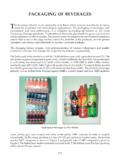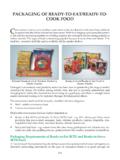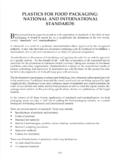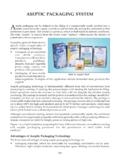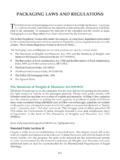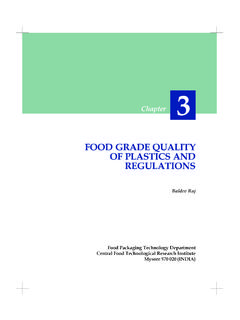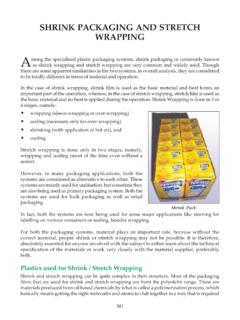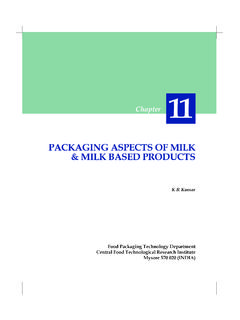Transcription of PACKAGING OF CEREALS AND CEREAL PRODUCTS - ICPE
1 109 PACKAGING OF CEREALS ANDCEREAL PRODUCTSI ndia produces a variety of food grains like paddy, wheat, maize, barley millets like, jowar,bajra, ragi. The country is self sufficient in grain production and is the second largest riceproducer in the world with a 20% 1 gives the details of food grains produced in 1 Food Grains Production in India(in million tonnes) [Source: Economic Survey of India, 2001-02]Grain processing is the biggest component of the food sector, sharing over 40% of the total primary processing sector shares 96% of the total value while the secondary and tertiarysector shares 4% of the total value grain processing industry covers a range of food PRODUCTS .
2 These include the basic primaryfood, such as wheat and rice PRODUCTS , sugar, oil, pulses and the processes for converting theminto edible form and processed food like biscuits, bakery PRODUCTS , breakfast food, etc. Growth inPackages for CEREALS and CEREAL Products110the industry until a few years ago was mainly in traditional sectors like rice, flour and oilmilling. However, swelling consumerism has seen the introduction of a range of new productslike breakfast CEREALS , texturised protein food, RangeCereal PRODUCTS and pulses can be broadly classified into the following groups: Whole CEREALS /pulses where only the husk of the grain is removed, rice, wheat, gram,lentils, etc.
3 Split pulses like tur dal, gram dal, etc. Milled grain PRODUCTS are made by removing the bran and usually the germ of the seedand then crushing the kernel into various sized pieces. These include wheat flour, maida,semolina (rawa), besan etc. Processed CEREALS and pulses like weaning food, breakfast CEREALS , etc. Ready mixes like cake mix, idli mix, vada mix FactorsThe factors influencing the quality of CEREALS and pulses are: Physical: Physical losses are caused by spillages, which occur due to use of faultypackaging materials. Physiological: Examples of physiological losses include respiration and heating ingrains, temperature, humidity and oxygen.
4 Biological: Losses due to micro-organisms, insects, rodents, grains and pulses are low moisture commodities due to which they are less susceptible tospoilage and have greater shelf-life. The spoilage mainly occurs due to moisture absorptionduring storage leading to fungal growth at high temperature and humidity. Before bulkpackaging and storage, the whole grains are fumigated to reduce microbial load and increasestorage following factors are to be taken into consideration while developing PACKAGING materialsfor CEREAL and CEREAL PRODUCTS : Protection against environmental conditions like humidity, temperature, etc The PACKAGING material should be able to withstand mechanical hazards during transportationand facilitate stacking several tiers high so as to optimize the use of available space To protect the contents from spillage To protect the contents from insect infestation To protect from external odour Easy to handle Economical and easily availableWhole Grains and Split PulsesThese are sold mainly in bulk quantities.
5 The requirements for bulk PACKAGING are therefore,111most important for these commodities. The PACKAGING materials used for bulk packing of cerealsand pulses are as follows: Jute Bags Woven sacks made out of high density polyethylene or polypropylene Multiwall paper Sacks. The multiwall paper sacks are not commonly used in India owingto its high cost and lack of proper BagsTraditionally, jute has been the PACKAGING material used for bulk PACKAGING of food grains andpulses. With the increasing growth of these commodities, there has been a quest to look atalternate PACKAGING materials due to the stagnant jute production. Plastic woven sacks have thepotential to fulfill this need in a cost-effective manner.
6 These are made either fromHDPE or of jute bags include: Availability: Food grade jute bags are not easily available. Mineral Oil Contamination: Mineral oil is used as a lubricant in processing of jutefibres. Mineral oil adds hydrocarbon odour to the fabric and some free radicals arealso found in mineral oil which affects normal metabolism of human , lubricants based on vegetable oil have been developed by Indian JuteIndustries Research Association (IJIRA) for manufacture of odourless and hydrocarbonfree jute fabric for food contact application. However, bags made out of odour freefabric are expensive. Poor resistance to UV radiation.
7 Susceptibility of the material to insect infestation and rotting. Poor resistance to corrosive chemicals. Insect Breeding: It is a regular practice in the grain trade to reuse bags. The structure ofjute fabric being porous, the insects like stored grains and pests find it easier to lay theireggs on its fibres. The eggs of stored grain pests are microscopic in nature and one canknow about the presence of infestation only when it gets developed into the larva bags can therefore serve as a potential source of Bag for Branded Basmati RiceJute Bag for Unbranded Products112 Many a times the used bags are contaminated with food items or with chemicals, and insuch cases they serve as a potential source of contamination.
8 Cost: Jute sacks are 5-6 times heavier than the sack made out of plastic material likeHDPE or Polypropylene for a similar weight pack. The jute goods are transported allthe way from east India to other parts of the country, which are thousands of milesaway. Owing to these factors, the cost of jute bags is much higher than the nature of jute PACKAGING is such that, lot of food packed therein gets exposed todeteriorating factors and germs. Air borne germs and the ones present in the storagegodowns may seek way through the pores of the fabric and may contaminate the food, when consumed may cause illness like food Density Polyethylene (HDPE)/Polypropylene (PP) Woven SacksHDPE and PP woven sacks have replaced jute bags in number of applications.
9 Severalplants manufacturing these sacks have come up in different parts of the country makingthe availability of these PRODUCTS possible at of HDPE and PP woven sacksinclude: Elongation at break of HDPE tapes is about15-20% in comparison to jute bags, whichis about 30%. Owing to this property HDPE woven sacks have better resistance todropping. HDPE/PP woven sacks do not impart anyodour to the food product packed in them HDPE/PP woven sacks are not attacked byinsects HDPE and PP woven sacks of strength equivalent to that of jute bags can be madeusing almost 70 times lower weight of the resin and hence are almost 60-65% cheaperthan the jute bags.
10 HDPE and PP woven sacks are the most hygienic material for packing of CEREALS andpulses and one need not reuse the same owing to their low cost. Fabric allows diffusion of air/gases easily through the gaps between the filament thusfacilitates ventilation of grains during earlier stages of harvest and penetration offumigants. Although HDPE/PP undergo degradation under UV light, it is possible to arrest thesame by using appropriate UV stabilizers. It is possible to laminate HDPE woven sacks with LDPE. The laminated bags protectthe product packed in the bag from moisture and also prevent the loss of productslike flours due to spillage, which usually occur through plain jute bags, which arecommonly used for packing of Woven Sacks113 Lamination of PP woven sacks with polypropylene is also possible, as the grade of PPsuitable for lamination is now available in the Packs for Whole FoodGrainsAlthough CEREALS and pulses are primarilypacked in bulk packs owing to the developmentof super markets and due to increase inconsumer awareness on the quality of foodproducts.
